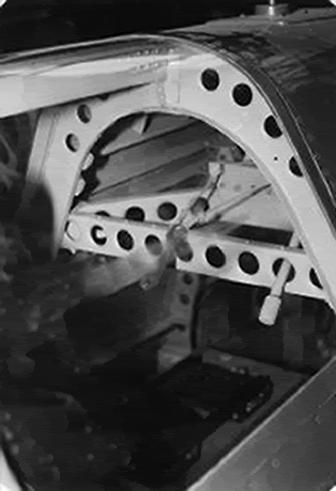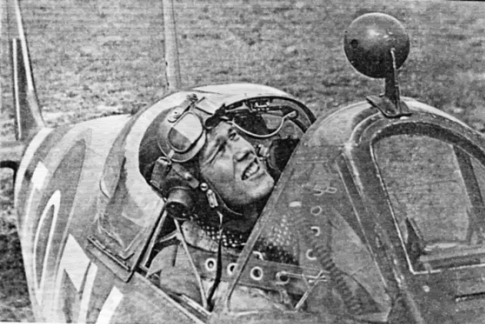The seat belts used on the Spitfire and other British aircraft of the era are often being referred to as the Sutton Harness. What exactly was the Sutton Harness?
The Sutton Harness used in single-seat fighters was a patented quick-release safety belt system introduced late during World War I. Over the years, several types of Sutton Harness were developed, covering both simple lap straps and four-point aerobatic harnesses. In the 1930s, the four-point Sutton harness was a broadly established standard in all RAF aircraft types, from de Havilland DH 82 Tiger Moth and Miles Magister to the Spitfire and Hurricane.
Sutton Harness
 The Sutton Harness system in the Spitfire
The Sutton harness commonly used during the initial to mid-war period consisted of four straps about 2'' wide that had a row of grommets spaced about 1and 1/2 " apart.
The shoulder straps of the harness were attached at a single point to a transverse cable which was attached by brackets bolted to the ends of the fuselage longerons behind the pilot's head/shoulders. The length of the cable provided a degree of shock absorption upon impact. Also, the wire could be slackened by means of a lever in the cockpit to permit the pilot to lean forwards.
The lap straps were attached to the lower airframe.
The four straps met in front of the pilot's chest. On the free end of one of the lap straps there was a brass locking cone that had a hole near the top that passed laterally through the cone for the locking pin. The pilot put the remaining three straps over the cone and locked the straps together in the pilots lap. The distinctive-looking locking pin was secured to the cone strap with a leather thong.
The Sutton Harness system in the Spitfire
The Sutton harness commonly used during the initial to mid-war period consisted of four straps about 2'' wide that had a row of grommets spaced about 1and 1/2 " apart.
The shoulder straps of the harness were attached at a single point to a transverse cable which was attached by brackets bolted to the ends of the fuselage longerons behind the pilot's head/shoulders. The length of the cable provided a degree of shock absorption upon impact. Also, the wire could be slackened by means of a lever in the cockpit to permit the pilot to lean forwards.
The lap straps were attached to the lower airframe.
The four straps met in front of the pilot's chest. On the free end of one of the lap straps there was a brass locking cone that had a hole near the top that passed laterally through the cone for the locking pin. The pilot put the remaining three straps over the cone and locked the straps together in the pilots lap. The distinctive-looking locking pin was secured to the cone strap with a leather thong.
 Shoulder straps of the Sutton Harness
When the pilot wanted to release himself, he pulled on the thong which withdrew the locking pin from the cone, freeing all straps simultaneously. It was the first quick release device.
Due to the way the shoulder harness was attached to the fuselage structure, the part of the harness going through the armoured bulkhead behind the seat and continuing to to the rear was one of the clearly visible thingies inside the rear glazing of the Spitfire (and sadly, is one thing regularly overlooked by modellers).
Shoulder straps of the Sutton Harness
When the pilot wanted to release himself, he pulled on the thong which withdrew the locking pin from the cone, freeing all straps simultaneously. It was the first quick release device.
Due to the way the shoulder harness was attached to the fuselage structure, the part of the harness going through the armoured bulkhead behind the seat and continuing to to the rear was one of the clearly visible thingies inside the rear glazing of the Spitfire (and sadly, is one thing regularly overlooked by modellers).
 The attachment cable of the Sutton harness visible under the rear glazing of the Spitfire.
The upper buckles are threaded through frame 11 (behind pilot) referred above and bolted to a bayonet coupling, connecting the shoulder straps to two wires going back over the antenna mounting frame, one each side of the mast foot, to an anchor point at frame 15. Another wire attached the bayonet coupling to the longitudinal frame under the rear glazing, probably to prevent the coupling from disappearing down into the fuselage when the straps were unfastened. The Y-shaped end of the shoulder straps went down behind the seat back, toward an anchor point on the seat mounting frame.
The attachment cable of the Sutton harness visible under the rear glazing of the Spitfire.
The upper buckles are threaded through frame 11 (behind pilot) referred above and bolted to a bayonet coupling, connecting the shoulder straps to two wires going back over the antenna mounting frame, one each side of the mast foot, to an anchor point at frame 15. Another wire attached the bayonet coupling to the longitudinal frame under the rear glazing, probably to prevent the coupling from disappearing down into the fuselage when the straps were unfastened. The Y-shaped end of the shoulder straps went down behind the seat back, toward an anchor point on the seat mounting frame.

This photograph illustrates how the pilot was strapped in the Sutton Harness. The locking pin was attached by a thread to one of the shoulder strap, and is often seen hanging along with the strap over the cockpit sill and down the fuselage side of aircraft on readiness. The pilot is Norwegian Kjell L'Abbee-Lund while serving with No. 611 Squadron.
With apologies to reg and Cliff for mentioning "fighters"!